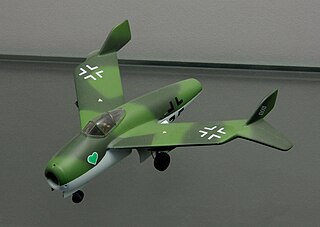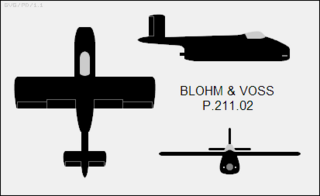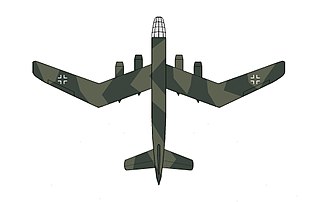Related Research Articles
The Blohm & Voss P 178 was a German jet-powered dive bomber of unusual asymmetric form, proposed during World War II.

The Blohm & Voss P 194 was a German design for a mixed-power Stuka or ground-attack aircraft and tactical bomber, during World War II.

The Junkers EF 126 was an experimental fighter proposed by the German Miniaturjägerprogramm of 1944–1945, for a cheap and simple fighter powered by a pulse jet engine. No examples were built during the war, but the Soviet Union completed a single unpowered prototype, which crashed during testing, and one in 1947 with a running engine.

The Blohm & Voss P 212 was a proposed jet fighter designed by Blohm & Voss for the Emergency Fighter Program Luftwaffe design competition during the Second World War.

The Blohm & Voss P 211 was a design proposal submitted by Blohm & Voss to the Volksjäger jet fighter competition of the Luftwaffe Emergency Fighter Program towards the end of the Second World War.

The Blohm & Voss P 213 was a submission to the Miniaturjäger programme of the Luftwaffe Emergency Fighter Program towards the end of the Second World War. The Miniaturjäger was to be powered by a pulse jet but the programme was scrapped in December 1944.

The Messerschmitt P.1110 was a design for a single-seat, high-altitude interceptor, prepared for the Luftwaffe by the Messerschmitt aircraft manufacturing company, under the Emergency Fighter Program during the last months of the Third Reich at the end of World War II.

The Blohm & Voss P 170 was a three-engined unarmed fast bomber and ground-attack aircraft project proposed by the aircraft manufacturer Blohm & Voss to the Luftwaffe during the Second World War.

The Blohm & Voss Bv P 188 was a long-range, heavy jet bomber design project by the Blohm & Voss aircraft manufacturing division during the last years of the Third Reich. It featured a novel W-wing planform with variable incidence.
The Blohm & Voss P215 was an advanced jet night fighter project by Blohm & Voss during the Second World War. With a crew of three and twin jet engines, it featured a tailless swept-wing layout and heavy armament. An order for three prototypes was received just weeks before the war ended.
The Blohm & Voss P 163 was a design project for an unconventional bomber during World War II. Constructed mainly from steel, its crew were accommodated in large wingtip nacelles, giving it a triple-fuselage appearance. Its propeller drive system was also unusual, with the central fuselage containing twin engines coupled to a front-mounted contra-prop.
The Blohm & Voss P 203 was a design project for a heavy fighter during World War II. Capable of filling the roles of night fighter, light bomber and ground-attack, it had mixed propulsion, having both piston engine driven propellers and jet engines.
The Blohm & Voss P 200 was a design project for a transatlantic transport flying boat during World War II. It was intended to go into production for Deutsche Lufthansa after the war.
The Blohm & Voss P 209 was one of a series of single-engined jet fighter design studies. Under development in the latter half of 1944, when the single-engined jet fighter requirement was issued the P 209 was radically revised to meet the deadline but was not taken further by the RLM.
The Blohm & Voss P 196 was the last of Blohm & Voss's World War II design projects for a "stuka" dive bomber and close support aircraft to replace the ageing Junkers Ju 87.
The Blohm & Voss P 197 was a design project during World War II for a single-seat twinjet fighter, in response to a requirement issued in 1944.
The Blohm & Voss P 202 was an unusual design study for a variable-geometry jet fighter during World War II. It was the first design to incorporate a slewed wing in which one side swept forward and the other back.
The Blohm & Voss P 204 was one of several design studies by Blohm & Voss for asymmetric dive bombers during World War II. It was also unusual in having hybrid propulsion comprising both piston and jet engines.
The Blohm & Voss P 192 was a design study for a dive bomber/ground attack aircraft intended to replace the Junkers Ju 87.
The Blohm & Voss P 184 was a German design for a long-range reconnaissance aircraft during World War II. Carrying a crew of five, it was of aerodynamically clean appearance and its wing had an unusually high aspect ratio.
References
Notes
Bibliography
- Hugh Cowin; "Blohm und Voss Projects of World War II", Air Pictorial, October 1963, pp. 312–316.
- David Masters; German Jet Genesis, Jane's, 1982, p. 29.
| This military vehicle article is a stub. You can help Wikipedia by expanding it. |
| This aircraft-related article is a stub. You can help Wikipedia by expanding it. |